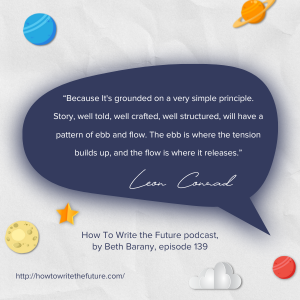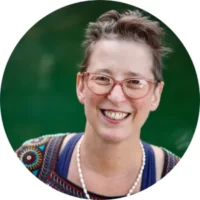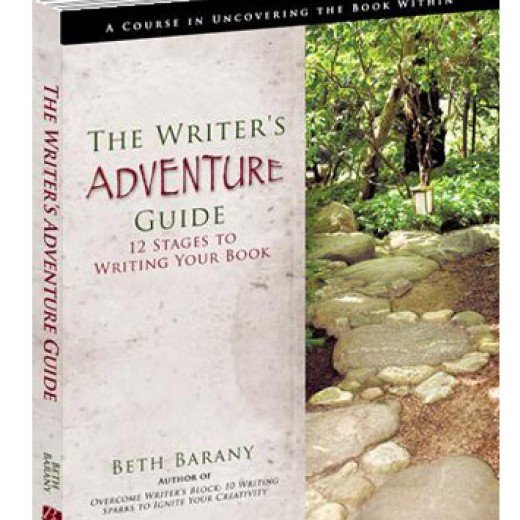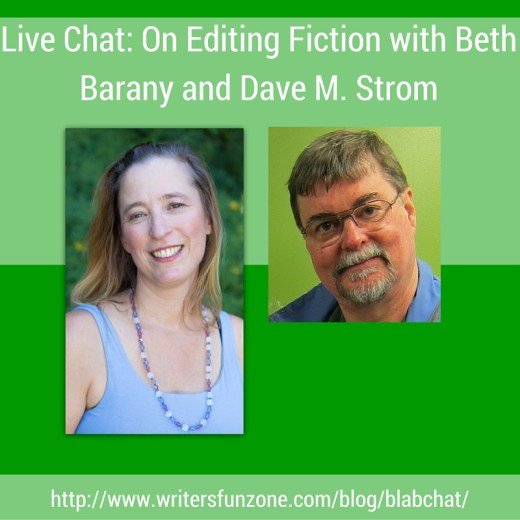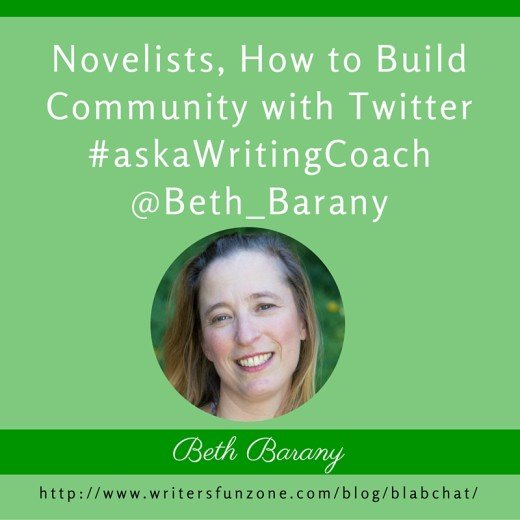Simple and Powerful Storytelling Structure with Leon Conrad
Simple and Powerful Storytelling Structure with Leon Conrad – How To Write the Future podcast, episode 139
“ Because It’s grounded on a very simple principle. Story, well told, well crafted, well structured, will have a pattern of ebb and flow. The ebb is where the tension builds up, and the flow is where it releases.” – Leon Conrad
In this episode of How to Write The Future podcast, host, Beth Barany talks to award winning author and tutor Leon Conrad where they discuss story structure, storytelling techniques, and how to map story structure for individual characters.
Platforms The podcast is available on Apple Podcasts | Buzzsprout | Spotify | Podcast Addict | Amazon Music| YouTube
RESOURCES
Story and Structure: A Complete Guide by Leon Conrad
https://www.amazon.com/Story-Structure-Complete-Leon-Conrad/dp/1906069255/
Free World Building Workbook for Fiction Writers: https://writersfunzone.com/blog/world-building-resources/
Sign up for the 30-minute Story Success Clinic with Beth Barany: https://writersfunzone.com/blog/story-success-clinic/
Get support for your fiction writing by a novelist and writing teacher and coach. Schedule an exploratory call here and see if Beth can support you today: https://writersfunzone.com/blog/discovery-call/
About the How To Write the Future podcast
The How To Write The Future podcast is for science fiction and fantasy writers who want to write positive futures and successfully bring those stories out into the marketplace. Hosted by Beth Barany, science fiction novelist and creativity coach for writers. We cover tips for fiction writers. This podcast is for readers too if you’re at all curious about the future of humanity.
This podcast is for you if you have questions like:
– How do I create a believable world for my science fiction story?
– How do I figure out what’s not working if my story feels flat?
– How do I make my story more interesting and alive?
This podcast is for readers too if you’re at all curious about the future of humanity.
ABOUT LEON CONRAD
Leon Conrad grew up among the souks and bazaars of Egypt. Early encounters with storytelling from a living ‘Arabian Nights’-type oral tradition started him on a life-long quest to explore the unique power the human voice has to inspire. A talented pianist and linguist, he studied music in London, UK, working with opera singers and musical theatre performers. He studied storytelling with Shonaleigh Cumbers, a Jewish storyteller from a living oral tradition. As an author, his ground-breaking book ‘Story and Structure: A complete guide’ has won several literary awards including the IPNE Nonfiction Book of the Year and was shortlisted for The People’s Book Prize. Leon set up The Unknown Storyteller Project in 2018 to help writers use story structure techniques to craft tighter stories and to spot and fix plot holes more effectively. As a tutor, he works with gifted and talented students age 7+, helping many to publish their work independently and traditionally. He runs courses for writers of all ages.
Twitter: https://twitter.com/LeonConrad
Instagram: https://www.instagram.com/unknownstorytellerproject/
LinkedIn: https://www.linkedin.com/in/leon-conrad/
Transcript for Simple and Powerful Story Telling Structure with Leon Conrad
Hey everyone. Welcome. Beth Barany, here I am, the host of How to Write the Future podcast, a writer, a teacher, creativity coach, and obviously podcaster. And I’m here to support writers, to help you write stories that really help us change the paradigm so we can live better lives, more full lives.
I believe that stories are so, so powerful. And when we vision and put that vision into our work, we help make it so, not just for ourselves, which is actually incredibly important, but also for our readers, which I think is just amazing and phenomenal. So the work we do here as storytellers is. It’s vital.
It’s vital for culture. And occasionally I bring guests onto the show.
[00:47] Guest Introduction: Leon Conrad
I am very excited to welcome in our guest today, Leon Conrad. Leon, welcome. Thank you so much for being here.
Thank you, Beth.
It’s a pleasure to be here. I’m really excited to read your bio so everyone can get to know you a little better.
[01:02] Leon Conrad’s Background and Achievements
So everyone, Leon Conrad grew up among the souks and bazaars of Egypt. Early encounters with storytelling from a living Arabian Nights type oral tradition started him on a lifelong quest to explore the unique power the human voice has to inspire. A talented pianist and linguist, he studied music in London, UK, working with opera singers and musical theatre performers.
He studied storytelling with Shonaleigh Cumbers, I hope I have that right, a Jewish storyteller from a living oral tradition. As an author, his groundbreaking book, Story and Structure, A Complete Guide, has won several literary awards, including the IPNE Nonfiction Book of the Year and was shortlisted for the People’s Book Prize.
Leon set up The Unknown Storyteller Project in 2018 to help writers use story structure techniques to craft tighter stories and to spot and fix plot holes more effectively. As a tutor, he works with gifted and talented students, ages 7 and up, helping many to publish their work independently and traditionally. He runs courses for writers of all ages.
And by the end of this episode, I will tell you, or Leon will tell you, how you can learn more about his work. Leon, welcome again. So excited to have you here.
Thank you, Beth. It’s lovely to talk to you, lovely to chat to you and other writers vicariously about a genre I love myself.
I love reading science fiction and fantasy and often enjoy working with writers in those genres as well as other genres.
Oh, perfect. Yeah. I am a science fiction and fantasy novelist and I cater specifically to science fiction and fantasy novelists since it’s the genre I know the best. And of course all are welcome here.
I have romance in my work. My husband who co teaches with me, he brings in thriller suspense. I’m actually writing a science fiction mystery series. I also have a lot of knowledge also about mystery. And I love it when people bring different kinds of stories together, like I have like science fiction, mystery, science fiction, mystery slash adventure, that kind of thing. So I have studied story structure a ton.
[03:13] Discussion on Story Structure
And I was really excited when you reached out. to be on the show because you have such a vast knowledge about story structure and I would love to hear more about that and more about how specifically can we take your understanding of story structure and how it can inform, those of us who are working on our science fiction and fantasy stories.
Of course, the most important thing I can say starting off is that the approach I use to story structure is grounded in an oral tradition, and the methodology works for people who like to structure and plan ahead of time, map out what they’re going to do, or people who are more intuitive and take the typical “pantser” approach.
Because iIt’s grounded on a very simple principle. Story, well told, well crafted, well structured, will have a pattern of ebb and flow. The ebb is where the tension builds up, and the flow is where it releases. Every story will have those elements in it. The number of times a story ebbs and flows, and why a story ebbs and flows, is what gives rise to different story structures.
Yes, that makes sense. And to me, it’s very akin to breathing, walking, the heartbeat. So I ground myself as a writer very much in the kinesthetic and in the body elements. And I love how simply you put that; it’s an ebb and it’s enough and it’s a flow.
[04:50] Fantasy Storytelling Techniques
And so the differences you’re saying, so let’s take fantasy since a lot of people have strong ideas about fantasy. And maybe a lot of our listeners grew up on fairytales and folktales like I did.
You also are very much rooted in an oral storytelling tradition. And all the fairytales and folktales that our parents may have read to us, or invented. My father would invent stories and just tell us stories. My father, he actually would read from the Arabian Nights to us. All of that is all… based in the oral storytelling tradition.
So can you get some more specifics in there and apply it to those of us who are working on fantasy? Give us some more details on this.
Well, for me, story happens across many genres. You’ve mentioned some of the most popular, but in my book Story and Structure, I show that the story of the three little pigs, the well known version of it. And the structure of a typical academic essay, or a mathematical proof, share exactly the same story structure.
And I call it the quest structure. In my book, I use six very simple, visually intuitive symbols to map a story structure. I talked about two of those main aspects, the ebb and the flow, the pull, the push. And I use a backward and a forward barb to symbolize them respectively.
Take the story of the three little pigs. We take the pigs of the character and I map story structures to individual characters, that’s very important. Whatever genre you’re writing in, you will probably focus on a character, main character, secondary characters, follow their individual storylines like this.
A story opens, you encounter a character at a particular point in their storyline, who, where, when, in what condition. We meet the three little pigs when they are just about to be thrown out of their house. Versions vary, different reasons, but they find themselves with a problem. They need to be able to set themselves up with their own houses and live as independent little piggies. Ideally, staying away from the big bad wolf.
As a result, they go on a journey. And by the time we get to the journey, we have been on an ebb, a backward tension thing with a problem, and we’re flowing forwards now. On that journey, they meet friends and helpers. That meeting makes them stop. That stop pulls the story up and stops the flow. So it’s mapped with a backward barb.
When they get their materials, when they build the houses, the story flows forward. Because it takes them towards their goal. But then the wolf comes in. That meeting is another backward step.
Fast forward to the end of the story, they defeat the wolf and end up, it’s very important to have a clear ending, living together in the brick house. And living there happily ever after.
And that conventional oral storytelling ending leads you out of the story and into the everyday world. The everyday dimension of being.
I love that. So it’s very clear how movement toward the goal is the flow and then the ebb. And we’ll see it as the water pooling away from the shore.
Energy is retreating. And we have the problem, the obstacle, the villain, antagonist, or even you were saying even when friends have come together to create, there’s a calm point, so it’s not always a negative thing, it’d just be that calm moment as well.
Exactly, yes. This is one structure of 18 I outline in the book, each one has a different character, each one exists because it arrives spontaneously in our consciousness, this is what I found by applying this methodology to the analysis of story structure, because it arises in response to a particular kind of problem we experience in everyday life.
I see. So the different types, you say there’s 18, are organized by the type of problem.
Yes.
Lovely. That’s great.
Knowing this will make it much easier for you to see where a story is going in a character’s storyline. When you feel that natural pattern, which goes with the grain of the brain, you can plan out if you want to. Or you could just flow in the writing, because you know where you’re going. You’re going to travel around, along very well oiled tracks.
Absolutely. That’s really wonderful. And some of the problems in, let’s say, in fantasy tend to be some kind of good versus evil. Or some kind of… this is one kingdom versus another, or one way of life versus another, and usually one typically wants to dominate or destroy the other.
So you have a story structure for that, I would imagine.
Yes, it’s interesting that the story structures that appear in fantasy very often are story structures that are linked with supernatural powers. The quest structure, as I outlined, the story of the Three Little Pigs, is typically found in folktales or problems that we can solve ourselves.
A mathematical proof or an essay, you have a problem, you want to go on a journey, you explore your methodology, you get your points pro, you get your points con, and you get to a conclusion.
In the fantasy world… You have supernatural beings who can just take a thunder, the bolt, and send down a lightning bolt, devastate a whole world as Zeus would in Greek mythology, when a supernatural being acts, typically they don’t act in a premeditated way.
They act in a spontaneous, reactive way to restore balance in the natural order when they perceived an imbalance, just like a goddess will intervene when a character’s fleeing from someone pursuing them in Greek myth. In Ovid’s Metamorphoses, for instance, boom, and there’s a transformation, a metamorphosis. Balance is restored, but things never really get back to the state they were in. And that, then opens up a whole new situation.
You can play with that. Structures that these particular interactions follow are different. The transformation structure, which I’ve just outlined, is the one that supernatural beings follow in Ovid’s Metamorphoses, and it goes, bim bam. Backwards, forwards, done.
Again, knowing that and building up to those kinds of actions, even if you’ve got a very ordinary character, sometimes in the heat of battle, their ability to act in a very spontaneous, emotionally charged, unusual way, as if possessed by a divine power, will animate that character and make it much more interesting for the reader to follow their storyline and–
Yeah. I definitely worked on that in my young adult adventure fantasy series, Henrietta the Dragon Slayer. It was all about her coming into her power and that power was personified or not personified, exemplified by the dragon stone that she acquires and her learning to become okay with this larger than life energy magic. And learning how to harness it. And I’m still, I’m working on now a short movie that I hope to turn into a TV show and same thing. She’s learning to harness the power of magic versus just relying on her skills. So I see that has that transformative, larger than life experience.
The thing about fantasy is that it builds metaphorically, allegorically, analogically on powers we have innate within us. The power to enchant with words. The power to speak and stand our ground, stand up for what we believe in. It takes courage, it takes strength, it takes conviction. And… it also is linked to a whole system of learning, I have a lot of respect for. That comes out of the oral storytelling tradition of the prom, nas murder and the classical liberal arts, what is the arts, grammar, logical and rhetoric and the number things that come after that. And the quadrivium are integrating and integrative tools for learning.
You’ll have to explain a little bit of that. Most of us Americans don’t have a classical education, like I’ve met many British people who do.
And, yeah, so explain what is, what was it, the quadrivium?
Let’s start with the trivium.
The three word based arts of logic, grammar, and rhetoric.
Logic is the art of working with that which we know.
Grammar is working with the art of putting it into words.
Rhetoric is the art of communicating it for different purposes.
They all work together. Logic helps us clarify our thinking. Grammar helps us convey our thoughts clearly in words. And rhetoric makes those words elegant, suitable for purpose.
And you get to decide what that purpose is. And if you are clear on your thoughts… If your words are well suited to your purpose, and if you present those words in a very well structured and crafted way, I don’t mean just the writing, the editing, the layout, the design, the illustration, the cover image, or you standing up and telling people about your book, reading from your book, if you like. Telling the story, then you have a really powerful act of communication that can, as you say, have a positive impact on the world.
That’s wonderful and all that has intention.
And I know I’m partway between someone who likes to plan and someone who doesn’t like to plan. But I do like to know the direction I’m heading in, after I’ve taken a lot from the world. I let it all, pour into the big pot and stir it up and add in all kinds of things, and then taking my understanding of story and structure and where I’m headed, create a safe container, and then sit down, and something emerges that I could have never planned.
Which I just adore. But I recognize I’ve done all those things and put a lot of attention on them. And then, of course, I spent a lot of editing time and figuring out how to package the book and how to… Present the book. So I, I love hearing what you’re saying because it represents also the tremendous amount of care and attention that artists put into their work to be able to convey something powerfully. Yeah, so thank you for that.
[16:05] The Art and Craft of Writing
You’re welcome. And I’m very glad to hear you say that because writing is both an art and a craft. One of my books is about the art and craft of writing. It’s a collection of writing games designed to encourage writers to have fun, learning the rules of grammar, of logic, of rhetoric.
And breaking the rules for the right reasons. When that happens, we unlock creativity, we unlock magic, we unlock enchantment that is there inherent in thought itself, in words themselves, in language, and in how we communicate. it ends where mystery, magic, and inspiration take us. A place of silent awe. And respect for the wonder that is story.
I love it. So there’s a fourth component.
Yes.
There are four number based arts that complete the seven liberal arts. The four number based arts are the study of arithmetic number, the study of geometry, number in three dimensions, the study of music theory and harmony, and the study of astronomy, three dimensional bodies in movement. And that animates the cosmos.
If you do it traditionally, actually, draw shapes. As you draw shapes, you find the inherent energies and patterns within them. The functions of the diagonals splitting a square in two and then expanding it. It’s actually very similar to how story works. Geometry gives us an insight into a world of tangible forms, which echo an intangible background, which is what we work with as writers.
Our words communicate ideas, those ideas we cannot communicate without the words, but they embody very powerful feelings, thoughts, experiences, which we would be lost without being able to communicate properly.
I love what you’re saying, embody, because emotion is, I feel conveying emotion and having our audience feel is our job as writers, as storytellers, as novelists.
And I love that connection with geometry, which was my favorite math as a teenager. I love drawing shapes and I was going to show some of my art. I have a ton of art all over. I’ve been doing all these circles and spirals and cross hatches and creating three dimensional layers with my art and feeling, not that I want to create three dimensional art, but I want to create the experience of three dimensions, which I realize in our stories is what we’re doing when we try to create complex characters that feel real, storylines that feel it’s feasible for them to move through and have these encounters and challenges.
[19:04] Science Fiction Storytelling Techniques
So let’s move to science fiction because as you started talking about astronomy, I just got a little bit of a jolt. I spend part of my free time watching tons of videos about what the James Webb Space Telescope has seen today, what the Euclid telescope has seen, the latest launches, and I’m also studying orbits, how do orbits work and understanding movement through space and how this blows my mind.
The earth, we all know the earth is going around the sun. We all know that all these planets are ringing our sun. We all know that we’re part of a solar system, but actually this, our entire solar system is also making a spiral through space and us along with it. It’s a bit dizzying when you start to really feel into that.
I didn’t know this. Just in the last few years, as I’ve been working on science fiction, did I see visualizations of this and just blew my mind that everything is moving. Nothing is static and everything is relative to something else. There is no absolute point in space, which also blows my mind because everything is relative to everything else.
And what does that mean for us as humanity, as we attempt to be a spacefaring species. These are things I think about as I work on my science fiction.
And so what do you bring with your story structure and your skill set, your tools, to us to help us write science fiction better?
Science fiction, to me, is no different to any other genre. You need strong characters, you need a strong philosophical question. That is not my original thought, it’s Ben Bovo’s, who I have a lot of respect for. He simplifies the approach to science fiction, fantasy writing, and I love that because I work a lot with young writers, as you mentioned at the beginning of the program, they need things to be simplified.
It doesn’t matter whether you know how the cosmos works, just show it does and show its wonder and the awe for it. I’ve been reading something about Newton’s discoveries recently. He… Did a lot of meditation, of reading classics, and he worked out his laws of gravity based on what he knew that classical investigators did with strings and weights.
Did you know that when you have a string that’s, maybe kept at attention by a particular weight and you add a weight to it that’s four times as heavy, the pitch goes up an octave, it doubles in frequency. And this is a simple experiment, anyone can do by realizing that and appreciating the fact that as above so below in the metric axiom.
He worked out that planets could very well behave the same way, and then he tested it out empirically, compared speeds, compared masses, compared sizes, and yes, that’s how he worked out gravity. But what he also understood or intuited or approached as an idea, very positively, was that the whole cosmos was a song.
A song that can enchant, that can sing you and you can be part of that song if you let yourself do it. If you do, that’s when the most powerful writing comes out, I think.
Yeah, I agree. I feel especially I’m now entering the refining process of the next novel and I use music tremendous, tremendously, tremendous amount, both as an inspiration, but also in helping me make decisions about tone and language and, when to cut or when to expand.
And I think a lot and research to find music that matches the book that I can say this is the song of the book.
Because I’m writing murder mystery set in this futuristic setting, it’s often a syncopated jazz. And it’s often mixed with some African rhythms and maybe some scatting and somewhat familiar but also new.
I invite writers, to find the music that matches their work, both from the internal perspective.maybe each character has their own tune ’cause they do, their dialogue needs to sound unique. Each character speaks differently and one of the ways to figure out the rhythm of their speech likening it to music.
I spent a lot of time on that, especially once the whole story is laid down and the emotional resonance is there, then I’ll get really in the weeds, word by word, figuring that out.
which is why in my book of writing games, I devote a whole chapter to sound and rhythm.
Oh, wonderful. I think that’s so important to bring people’s attention to that.
[23:52] Closing Remarks and Contact Information
And as we close, is there any advice that you would like to offer writers as they look at their work to help remake themselves, remake how we could be in the world. Anything about that future facing look that I bring to this work that I’m inviting you to chime in on.
I think the most important thing for me is to be clear on your stance. By stance, why it is you stand up for whatever message it is you want to communicate.
It’s the why behind the what that’s really important. Very often when we want to put a message out into the world we focus on the positive. That’s generally a good thing to do, but sometimes it’s worth considering writing the, “Oh. So that’s what would happen. I don’t want to go there story.”
Absolutely. And while I’m not someone who reads dystopia or talks in any great length about dystopia, I know that it serves a very powerful purpose in society and helping us look at what we don’t want. So absolutely. And in every powerful story, even stories that are trying to maybe paint a more positive picture of what could be, we also have to confront the darkness in there to make the story feel real and to have weight. Because even the stories I’m working on, I still have murder, I’m writing murder mysteries, I still have struggles, I still have power plays, I still have things that, I don’t know if humanity will ever resolve certain things.
Stories don’t have to be dystopian to have that quality I’m talking about. Tragedy is very well written about, very well practiced genre. And Aristotle thought it was cathartic, it had a soul cleansing function.
Comedy is great, it makes us laugh. Comedy works when we get things to almost a tragic point. And then, through the deus ex machina, the magical ending, everything turns out okay. That’s when it really works.
Yeah, the catharsis of a good story. Great. Thank you so much, Leon. If people want to reach out to you, what’s the best way that they can do that?
Very simple. LeonConrad.com. Find out about the courses I do, sign up for the mailing list, contact me if you want some help shaping anything to do with story structure. I run weekly drop in classes half an hour for writers just playing fun games, getting the art and craft to sizzle and sparkle.
Thank you so much, Leon. And, until next time.
Thank you for having me, Beth. Look forward to it.
[26:28] Write Long and Prosper
All right. That’s it for this week, everyone.Check out the World Building Workbook for Fiction Writers. And that’s a free workbook, downloadable for you. Great, everyone. So signing off. Write long and prosper.
Loved this episode? Leave us a review and rating here: https://www.buzzsprout.com/2012061
Need instructions on how to leave a review? Go here.
***
ABOUT BETH BARANY
Beth Barany teaches science fiction and fantasy novelists how to write, edit, and publish their books as a coach, teacher, consultant, and developmental editor. She’s an award-winning fantasy and science fiction novelist and runs the podcast, “How To Write The Future.”
Learn more about Beth Barany at these sites:
Author site / Coaching site / School of Fiction / Writer’s Fun Zone blog
CONNECT
Contact Beth: https://writersfunzone.com/blog/podcast/#tve-jump-185b4422580
Email: beth@bethbarany.com
LinkedIn: https://www.linkedin.com/in/bethbarany/
IG: https://www.instagram.com/bethbarany/
TT: https://www.tiktok.com/@bethbarany/
FB: https://www.facebook.com/bethbarany
X: https://twitter.com/BethBarany
CREDITS
- EDITED WITH DESCRIPT: https://www.descript.com?lmref=_w1WCA (Refer-a-Friend link)
- MUSIC CREDITS : Music from Uppbeat (free for Creators!): https://uppbeat.io/t/soundroll/fuzz-buzz License code: UMMKDRL02DFGKJ0L. “Fuzz buzz” by Soundroll. Commercial license: https://musicvine.com/track/soundroll/fuzz-buzz.
- DISTRIBUTED BY BUZZSPROUT: https://www.buzzsprout.com/?referrer_id=1994465 (Refer-a-Friend link)
- SHOW PRODUCTION BY Beth Barany
- SHOW CO-PRODUCTION + NOTES by Kerry-Ann McDade
C 2024 BETH BARANY
For more “How To Write the Future” episodes, go here.
If you’d like to invite Beth onto your podcast, drop her a note here.
✅ Like the work we do? Tip us! https://ko-fi.com/bethbarany


